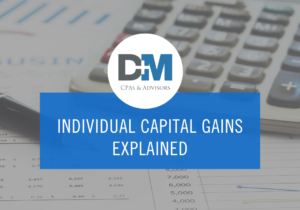Individual Capital Gains Explained

At year-end, we get calls from clients asking about individual capital gains as they harvest gains and losses. This is an overview of the rules.
Capital gains are grouped and taxed based on the holding period. Long-term capital gains or losses are generated by the sale of assets held over 12 months, and short-term have a holding period of 12 months or less. This character is maintained with a pass-through entity. A partnership or mutual fund may pass out long-term gains to you.
All capital assets gains/losses – short and long term are netted. It doesn’t matter if you generate a long-term gain selling stocks or land; they are reported together:
- Short-term capital gains and losses are netted. Carryover of any short-term losses from a prior year is first applied to short-term gains, if any.
- If you have net short-term losses, they are applied against net long-term gains.
- Net short-term gains after netting against long-term losses are taxed at ordinary income rates.
- If the result is net long-term gains, that amount is taxed at capital gains rates.
- What happens if the net short-term and long-term is a loss? Individuals can use only $3,000 to offset ordinary income. The remaining loss is carried over to the next year. Note: Alabama has no such limitation, and all net losses can be applied to other income.
OK, let’s run through a couple of examples.
In 2022, Rusty had $150,000 of ordinary income along with net short-term capital losses of $10,000 and net long-term capital gains of $15,000. After netting, Rusty’s capital gains are $5,000 (long-term) and taxed at capital gains rates.
Mary had $75,000 of W-2 income along with $5,000 of short-term capital losses and $3,000 of net long-term losses. Her total capital losses are $8,000. She can use $3,000 against ordinary income, and the remainder is carried forward.
What Do I Pay on Capital Gains?
Federal
The special income tax rates on qualified dividends and long-term capital gains range from 0% to 20%. In 2023, the rate is 0% for certain individuals with taxable income below $89,250 (married filing joint) or $44,625 (single). That’s right, a married couple could have almost $90,000 of qualified income and pay $0 of Federal income tax. The rate increases to 15% for those with taxable income above the 0% threshold but below $553,850 (married filing jointly) or $492,300 (single). Capital gains for those with income above the 15% threshold are taxed at 20%.
Short-term capital gains are taxed as ordinary income rates – like interest, W-2 income, and nonqualified dividends.
Net Investment Income tax (NIIT) is a 3.8% additional Medicare surtax. This applies to married filing jointly taxpayers with taxable income over $250,000 (single, $200,000). The tax applies to passive income like interest, dividends, rents, capital gains, and income from passive activities.
So, for federal purposes, the maximum rate applied to capital gains is 23.8% – 20% plus the 3.8% surtax.
Alabama
Alabama, like many states, has no special capital gains rate. Capital gains are taxed at 5%, like any other income.
Beware wash sales
If you sell a security at a loss and repurchase the same security within 30 days, the loss is disallowed and moved to the basis of the new purchase.
As always, if you have specific questions, contact your Dent Moses advisor. We are here to help.